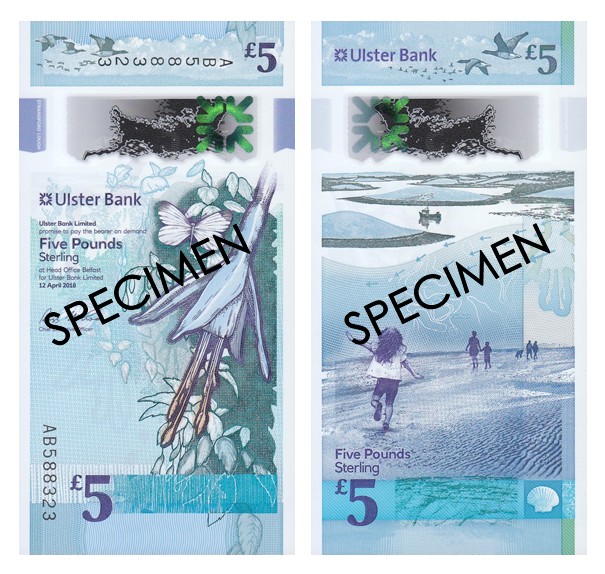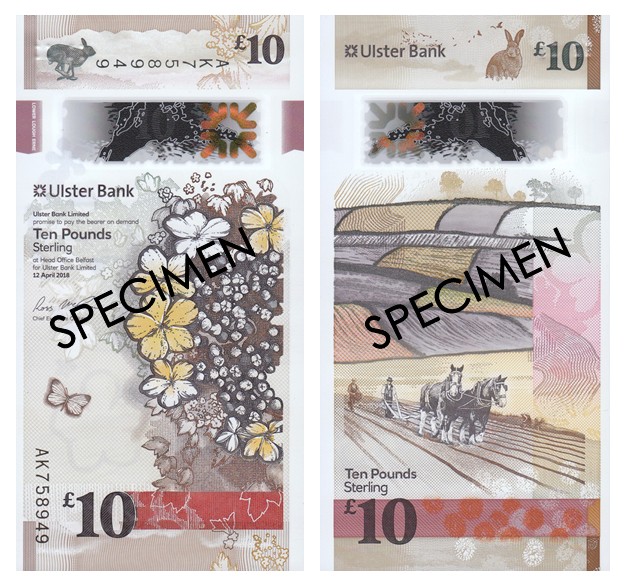
The Ulster Bank Plc, a subsidiary of the royal Bank of Scotland, have released two of their new denominations on February 27, 2019, which is launched as part of a new family of vertically designed banknotes entitled “Living in Nature”. Initially unveiled in May 2018, the new banknotes which carry the date “12 APRIL 2018” are produced on polymer, the Ulster Bank now making the move to this substrate as the Bank of England have done with the issue of both the £5 and £10 banknote values. Below the date is the signature of Chief Executive Ross McEwan, in this position since October 2013.
The new notes also include advanced security features that will make the notes much more difficult to counterfeit. The new series was developed by a panel of experts and people from across Northern Ireland, according them an opportunity to show the creativity and talent of local people. The concepts were shared with the graphic design firm Nile who are based out of Edinburgh and who collaborated with several Northern Irish illustrators and photographers, formatting the concept to the final results shown. Additionally, Type foundry specialists Fontsmith worked on the typography seen, while the Glasgow-based design studio O Street also worked on the graphics. These two banknotes are the start of what will make up the new family of four banknotes, two of the other denominations awaiting issue at a later date.
The £5 banknote (blue, 125 / 65 mm):
Featured on the reverse is Strangford Lough, a large sea loch or inlet in County Down, in the east of Northern Ireland. The design also features people running along the beach, poignantly representing much of the island’s history of migration and family separation with many Irish immigrating to America during the last two centuries. A king scallop from Strangford Lough is placed to the lower right corner, a reminder of the many who earned their living on the seas as fishermen. Also featured in this new innovative design is an image of Brent Geese in flight. Every autumn, these birds leave their breeding grounds in east Canada and travel to Ireland to spend the winter, in particular, making Strangford Lough their home. The obverse or front side includes the image of a sprig of fuchsia, commonly found in hedgerows and featured in tourist leaflets throughout Northern Ireland.

The £10 banknote (brown, 132 / 69 mm):
Featured on the reverse side are images of a farmer ploughing farmland adjacent to Lough Erne, the two connected lakes in County Fermanagh which is the second-biggest lake system in Northern Ireland and Ulster. Also shown is the Irish hare, which is one of the island’s longest established indigenous species of mammal. Displayed on the front or obverse side is the Guelder-rose shrub, these beautiful deciduous plants are well-known for their light fragrance and cream petal displays. They thrive alongside lakes, in hedgerows and in thickets across the Northern Ireland countryside, sometimes reaching 4 metres or 12 feet high. A Cryptic wood white butterfly, which only found in Northern Ireland, is shown just to the lower right.
Additional security features include:
Colour shifting ink: This application is in the shape of the Ulster Bank logo, and located to the upper right corner as viewed from the front. When the note is tilted the colour of the logo shifts colour and depending on the denomination, the colours can change from blue to green (£5) or from gold to brown (£10).
Embossing application: An embossed single numeral can be seen and felt on the note’s clear window.
Tactile application: A series of raised dots is located on the £10 and can be felt on the upper left corner when viewed from the front side. These tactile dots are used to identify the note for visually impaired persons.
Iridescent Ink application: As seen on the front left side, and when the note is tilted in light, an iridescent print is visible. On the £10 note, a single rose bloom as well as a cluster of Guelder roses can be seen. On the £5 note, a fuchsia blossom is seen along with a cluster of leaves.
UV Printing: On the reverse, the numeral of the denomination of the banknote as well as an image of a parent & child (£5) holding hands – and a display of Glade Ulster potatoes, (£10) a strain developed in County Antrim.
The issuing authorities in Northern Ireland
There are presently four commercial banknote issuing authorities in Northern Ireland which are the Danske Bank (formerly Northern Bank), Ulster Bank, Bank of Ireland and First Trust Bank. Each of these Banks are authorised to issue their own banknotes in conjunction to Bank of England banknotes but only Ulster Bank and Bank of Ireland print and issue £5 denominations. Ulster Bank’s new vertically formatted designs for both sides are the first series or family of notes in the UK to adopt this concept but are not the first bank in the UK to introduce polymer banknotes nor a design with a vertical concept. Northern Bank, before it was acquired by Danske Bank, issued a special £5 polymer note in 1999 to celebrate the millennium. The Bank of England introduced its first polymer note, a £5 note featuring Sir Winston Churchill, in 2016.
The issue of the new polymer banknotes coincide with the recent announcement by the First Trust Bank on February 12, 2019, that they will discontinue the production and issue of banknotes from June 30, 2020. The First Trust Bank cited the reason behind their decision was the increasing use of digital payments and mobile technology.
Ulster Bank currency notes are redeemable and/or for use only in Northern Ireland and always exchangeable for Bank of England banknotes. For additional information on Ulster Bank and other Northern Ireland currency notes, please visit the website of the Association of Commercial Banknote Issuers (ACBI).
This video released by the Ulster Bank Northern Ireland tells you more about the new polymer banknotes.
The Bank of England announced the production of polymer banknotes in 2014 already.
Strangford Lough is located in the east of Northern Ireland. Its beauty and cultural importance make it a popular tourist destination. You can find more information on the National Trust website.
Lough Erne is also well worth a visit. The Encyclopaedia Britannica tells you more about the fascinating lake system.



